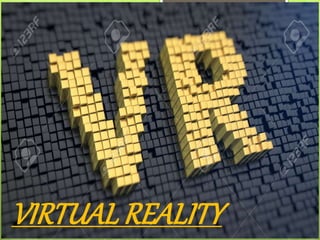Virtual reality
•Als PPTX, PDF herunterladen•
2 gefällt mir•713 views
Virtual reality is an artificial environment that is created with software and presented to the user through interactive devices. It involves immersing the senses in a 3D computer-generated world. The history of VR began in the 1950s with flight simulators for pilots. Major developments included research programs in the 1960s, commercial development in the 1980s, and the first commercial entertainment system in the early 1990s. There are different types of VR including immersive VR, augmented VR, video mapping, and desktop VR. Popular applications of VR include gaming, education, and training. The Oculus Rift is a virtual reality headset that provides an immersive stereoscopic 3D viewing experience.
Melden
Teilen
Melden
Teilen

Empfohlen
Empfohlen
Weitere ähnliche Inhalte
Was ist angesagt?
Was ist angesagt? (20)
Andere mochten auch
Andere mochten auch (20)
Oculus rift, Virtual Reality, Division of Facebook

Oculus rift, Virtual Reality, Division of Facebook
[Meetup Windows Apps 3D] Présentation d'Oculus Rift par Valentin Billotte![[Meetup Windows Apps 3D] Présentation d'Oculus Rift par Valentin Billotte](data:image/gif;base64,R0lGODlhAQABAIAAAAAAAP///yH5BAEAAAAALAAAAAABAAEAAAIBRAA7)
![[Meetup Windows Apps 3D] Présentation d'Oculus Rift par Valentin Billotte](data:image/gif;base64,R0lGODlhAQABAIAAAAAAAP///yH5BAEAAAAALAAAAAABAAEAAAIBRAA7)
[Meetup Windows Apps 3D] Présentation d'Oculus Rift par Valentin Billotte
See like a terminator: augmented reality with oculus rift - Martin Förtsch

See like a terminator: augmented reality with oculus rift - Martin Förtsch
Ähnlich wie Virtual reality
Ähnlich wie Virtual reality (20)
VIRTUAL REALITY SEMINAR PPT WITH AWESOME AUTOMATIC ANIMATIONS 

VIRTUAL REALITY SEMINAR PPT WITH AWESOME AUTOMATIC ANIMATIONS
Mehr von chahat aggarwal
Mehr von chahat aggarwal (7)
Kürzlich hochgeladen
https://app.box.com/s/7hlvjxjalkrik7fb082xx3jk7xd7liz3TỔNG ÔN TẬP THI VÀO LỚP 10 MÔN TIẾNG ANH NĂM HỌC 2023 - 2024 CÓ ĐÁP ÁN (NGỮ Â...

TỔNG ÔN TẬP THI VÀO LỚP 10 MÔN TIẾNG ANH NĂM HỌC 2023 - 2024 CÓ ĐÁP ÁN (NGỮ Â...Nguyen Thanh Tu Collection
Mehran University Newsletter is a Quarterly Publication from Public Relations OfficeMehran University Newsletter Vol-X, Issue-I, 2024

Mehran University Newsletter Vol-X, Issue-I, 2024Mehran University of Engineering & Technology, Jamshoro
Kürzlich hochgeladen (20)
TỔNG ÔN TẬP THI VÀO LỚP 10 MÔN TIẾNG ANH NĂM HỌC 2023 - 2024 CÓ ĐÁP ÁN (NGỮ Â...

TỔNG ÔN TẬP THI VÀO LỚP 10 MÔN TIẾNG ANH NĂM HỌC 2023 - 2024 CÓ ĐÁP ÁN (NGỮ Â...
Micro-Scholarship, What it is, How can it help me.pdf

Micro-Scholarship, What it is, How can it help me.pdf
Kodo Millet PPT made by Ghanshyam bairwa college of Agriculture kumher bhara...

Kodo Millet PPT made by Ghanshyam bairwa college of Agriculture kumher bhara...
This PowerPoint helps students to consider the concept of infinity.

This PowerPoint helps students to consider the concept of infinity.
UGC NET Paper 1 Mathematical Reasoning & Aptitude.pdf

UGC NET Paper 1 Mathematical Reasoning & Aptitude.pdf
General Principles of Intellectual Property: Concepts of Intellectual Proper...

General Principles of Intellectual Property: Concepts of Intellectual Proper...
Virtual reality
- 2. WHAT IS VR? VIRTUAL REALITY IS -Artificial Environment -Interaction with human senses -Input from persons actions and reactions.
- 3. Why is Virtual reality needed? It will take us to the world generated by Computer such as a room, or interior of Human body.
- 5. In 1950’s flight stimulators were built by US air force to train student pilots. In 1965, a research program for computer graphics “the ultimate layout” was laid out. In 1988, the commercial development of VR was developed. In 1991, first commercial entertainment VR system “virtuality” was developed. History
- 8. Immersive VR Video Mapping Desktop VR [Window on a World(WoW)] Augmented VR Types of VR
- 9. 1. Immersive VR It is the feeling of Involvement of user with Virtual world.
- 11. 2. Augmented VR It involves literally augmenting reality with Virtual information.
- 12. 3.Video Mapping It shows how users body interact with the world.
- 13. 4. Desktop VR It involves displaying a 3d virtual world on a regular desktop display Eg. Modern computer games.
- 15. What is Oculus rift? (next generation virtual reality) It is a new set of 3D virtual reality gaming Goggles that let you step into your favorite game.
- 16. Its high refresh rate and low persistence provides immersive wide field of view.
- 17. How it works?
- 18. Important points about rift Provides stereoscopic 3D view Ultra wide field of view Head tracking Wearable and affordable
- 19. Target segments
- 22. HMD(Head Mounted Display) Worn on head like a helmet or face mask. Has a small display optic in front of one eye (Monocular HMD) or can have it on each eye (Binocular HMD) to reproduce a stereoscopic vision.
- 23. CAVE (Cave Automatic Virtual Environment) Surround-screen Projection-based Coupled with head and hand tracking systems.
- 24. BOOM (Binocular Omni-Orientation Monitor) Head-coupled stereoscopic display device.
- 25. Data gloves Mounted along the fingers which accurately measure the position and movement of the fingers and wrist. The user manipulate the movements of the virtual environment using the glove.
- 26. Motion tracking Uses a combination of computer chips, sensors and cameras to record humans in motion. Designed for head and hand tracking in VR games, simulations, animations, and visualizations.
- 28. Pros of VR Stimulate real life situations. Making learning fun and interesting. Save on cost. Complex situations Made easy. A safe environment’.
- 29. Cons on VR •Expensive equipment. •Cannot be used by everyone. •Leads to weight gain. •Addiction.
- 30. Conclusion Its sole objective is to provide a user friendly and thrilling experience. It will soon be most exciting source of ‘entertainment’ in our homes.
- 31. Thank You